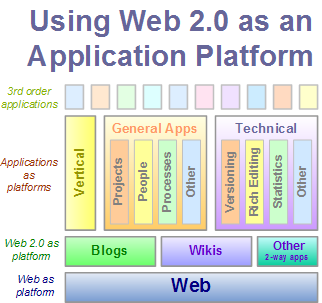Blogs, wikis, and Web 2.0 as the next application platform

My previous post discussed how IBM is planning to use Web 2.0 software like wikis as a foundation upon which to build so-called situational software. These are instant applications which can be assembled just-in-time (and not created from scratch) from the rich pallette of services and feeds available on the Web and in the enterprise. They are situational because they can be created right as the situation they are needed for appears, and even thrown away when the reason for their existence goes away. This could also result in less requirements speculation and creep, two well known problems with longer, more drawn out development processes.

But this highlights an interesting trend; the use of blogs and wikis as genuine application platforms upon which to build software by allowing the addition of widgets, version management features, analytics, domain specific structure (i.e. structured blogging and microformats), or anything that's needed to support a situational application. Now the idea of turning applications into platforms is a very Web 2.0 concept and two of the most common embodiments of the read/write Web, blogs and wikis, actually make a lot of sense as the actual foundation for building collaborative and social software. Why?
Blogs and wikis are an excellent starting point for creating Web 2.0 applications because they are already the most basic models for capturing and sharing content. This is a large part of the reason why they have become so popular; by lowering the barrier to user contributions by offering simple usage models (usually just an input field or two and an edit/save button). As they become more popular, blogs and wikis also form a fundamental common reference model. This can make adding related functionality on top them make more conceptual sense from a user experience perspective, right from the start. Note that most blogs and wikis aren't able to be extended without real programming, though some, like IBM's QEDwiki will be built specifically for this model of development.
As an example, I wrote recently about adding an enterprise context for blogs (aka Enterprise Web 2.0) and publically requested more examples of how to apply blogs to the enterprise. In direct response, Rod Boothby was kind enough to help take things in the direction of a blog development platform by providing specific examples of extending them for the purposes of tracking projects (Project Pages) and human resources (People Pages), two small but excellent examples of the possibilities of Web 2.0-as-platform.
Usable mental context, both in the enterprise and by many users, is still uncommon
Of course, the real obstacle to using blogs and wikis as a platform in the enterprise (though probably not the public Web) is still overall context. Jon Udell had an insightful post yesterday where he observed that there are two prerequistites to effective reading: Motivation and context. The corrolary likely applies to Web 2.0 as well; most enterprises have lots of motivation to do things, but still lack good context. In the case of Enterprise Web 2.0 this is a generally low level of understanding of how exactly user generated content and peer production will benefit them. For example, how many corporate intranets have you see recently have a Create an Intranet Blog Now button?
This apparent lack of context brings us full circle to the concept The Long Tail of IT demand, which posits that many of the remaining opportunities to leverage IT in the enterprise and generate additional return on investment is by exploiting previously untappable IT demand. This can be self-service IT; pulling together solutions by taking blogs, wikis, adding feeds, widgets, and Web services to form enterprise mashups. Or it can be in mass customized customer relationship management, so easy and cheap to tailor using Web 2.0 technologies, that customers (internal and external both) get more of what they want by helping themselves and creating it.
Naturally, it's essential to have customers that are Web 2.0 literate, and know they don't have to accept what they are given and can combine, remix, tweak, and adjust their services to be just what they need. Still, blogs and wikis are not common knowledge to the majority of those in the business rank and file (or as Rod Boothby observes, they still think they're for kids.) But that will only continue to improve as the next generation of workers enter the workforce in the next few years.
Will you use blogs and wikis for an application platform? Why or why not?